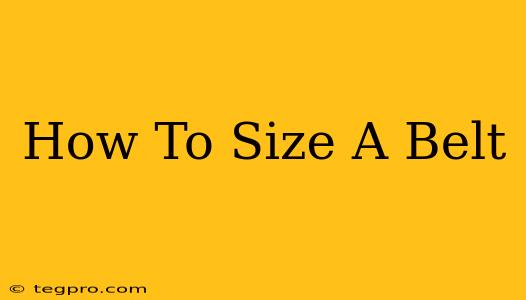Finding the perfect belt can elevate any outfit. But before you can rock that new accessory, you need to know how to size a belt correctly. Getting the wrong size can lead to discomfort and a less-than-stylish look. This comprehensive guide will walk you through the process, ensuring you find the perfect fit every time.
Understanding Belt Sizing: More Than Just Inches
Unlike pants or shirts, belt sizing isn't directly related to your waist or pant size. It's all about the length of the belt itself, measured from the buckle to the hole you'll be using. This means two people with the same waist size might need different belt sizes depending on their preferred fit and the style of belt.
Key Factors Affecting Belt Size:
- Waist Size: While not a direct measurement, your waist size is a good starting point. A properly fitting belt should comfortably sit at your waistline.
- Belt Material: Leather belts can stretch over time, so consider this when choosing a size. Other materials like canvas or nylon offer less stretch.
- Preferred Fit: Do you prefer a snug fit, or do you like a little extra room? This influences which hole you'll use and therefore the overall belt length you'll need.
- Belt Style: The type of buckle and belt style can slightly influence the overall feel and fit. A larger, more substantial buckle might require a slightly longer belt.
How to Measure for a Belt: A Step-by-Step Guide
Here's how to accurately determine your belt size:
- Measure Your Waist: Use a tape measure to determine your waist circumference at the natural waistline where you plan to wear the belt.
- Add 1-2 Inches: Add an extra inch or two to account for buckle overlap and desired fit. This allows for comfortable adjustment through the belt holes. A snugger fit might require less added length.
- Consider Your Pants Size: If you know the size of your pants that fit well, you can use this as a rough estimate, keeping in mind the factors mentioned above.
- Use an Existing Belt: If you have a belt that fits well, measure it from the buckle end to the center hole you typically use. This provides the most accurate size reference.
Tips for Choosing the Right Belt Size
- Try Before You Buy (If Possible): The best way to ensure a perfect fit is to try the belt on. Most stores allow you to do this before purchase.
- Check the Size Chart: If buying online, carefully review the seller's size chart and their sizing guidelines. Pay close attention to the length measurements provided, not just the stated size.
- Consider Multiple Holes: Look for belts with several holes to provide maximum adjustability as your waist size might fluctuate.
- Allow for Stretch: Keep in mind that some belts will stretch over time, especially leather belts. If unsure, it's often better to choose a slightly smaller size, especially with leather.
Common Belt Sizing Mistakes to Avoid
- Relying Solely on Waist Size: Your waist size is just a starting point. Ignoring the other factors can lead to an ill-fitting belt.
- Ignoring Buckle Size: A large buckle requires a longer belt to accommodate the overlap.
- Not Considering the Material: Different materials stretch differently. Leather belts are prone to stretching more than fabric belts.
By following these steps and considering the factors mentioned, you can confidently select the perfect belt size every time, ensuring comfort, style, and a perfectly accessorized look. Remember, the most crucial aspect is finding a belt that fits comfortably and allows you to use the middle holes for optimal adjustment.

